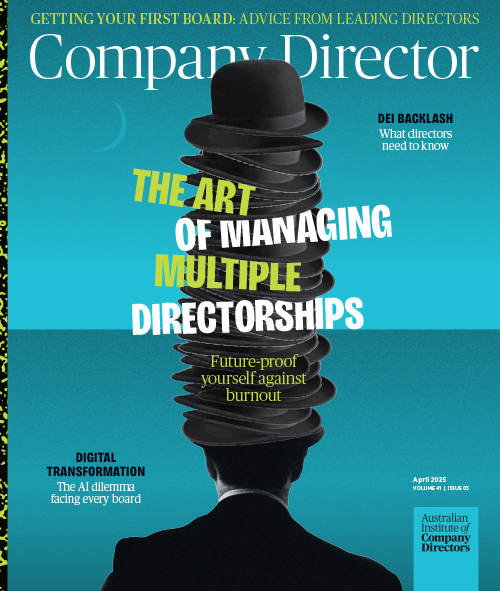With the interests of about 130 of Australia’s biggest businesses from a diverse range of sectors to consider, lobby group the Business Council of Australia is looking for strong action on multiple fronts as the nation goes to the polls.
CEO Bran Black and president Geoff Culbert have refined the organisation’s focus to a handful of major issues — with readymade policy solutions.
Former Sydney Airport CEO Geoff Culbert became president of the Business Council of Australia (BCA) in February 2024, when CEO Bran Black, a lawyer and former government adviser, was just six months into his new role at the powerful advocacy group. This duo is now pushing a master plan for the benefit of whoever wins the federal election, as they set their sights on a prosperous future for generations to come.
President’s POV
My first impressions of Bran were very positive. He’s extremely smart, deep in detail, evidence-based, high in integrity and not ideological. Importantly, what came across initially was that he was doing the CEO’s role for the right reasons — to drive the growth and prosperity of the country.That really appealed to me, because the job of the BCA is to advocate for the role of business, but that’s done through the lens of what’s in the interests of the country long-term. There’s clear alignment between those two.
When I was appointed, Bran was only a few months into his role and it very quickly became apparent he and I shared the same perspective and were aligned on the strategic approach and the issues we needed to address. I believe it’s critically important for a chair and CEO to align on strategic direction early because, after that time, it’s all about execution.
As CEO at Sydney Airport, I worked with two exceptional chairs in Trevor Gerber and David Gonski AC FAICDLife — and learned a lot from both in a very tumultuous time [during the pandemic], a genuine crisis for the aviation industry. Both David and Trevor were wise and considered, extremely supportive, but also clear about expectations.
A CEO role can be quite isolating. You need someone to bounce ideas off who’ll give you unbiased advice. That’s what I got from Trevor and David and that’s what I try to bring to my relationship with Bran.
Every job has its challenges. The nature of BCA’s work is very closely aligned to the political cycle and, while the challenges are different to running an ASX-listed company, the themes are the same.
I know CEOs want to have an impact on day one and get moving, but from my own experience, you need to settle into the job and do a lot of listening. I encouraged Bran to have a good think about what he wanted to achieve and what was most important from a strategic perspective.
He met with all our 130 members in his first few months and spent a lot of time with the BCA team and with government. From that stakeholder engagement, he was able to formulate the strategic direction. It wasn’t that different from what his instincts were telling him and what my instincts were telling me.
The big five
For the lead-up to the election, we’ve focused on the big five questions aligned with the issues most important to the electorate — easing the cost of living, tackling the housing crisis, achieving net zero by 2050 with affordable, reliable energy, paying for health and care services, and developing a skilled workforce for the future. Over the course of last year, those five issues intensified for the electorate and that’s been supported more recently by the polling. We’ve outlined policies needed to solve these challenges and the role business will play in driving outcomes.
There are so many issues you could address at any time and the BCA membership base is very broad, but sometimes less is more. If you try to prosecute every single one, you lose focus on the critical few. It’s an ongoing process and whoever wins the election will have ownership of these problems. We’ll stay the course and continue to push for good policy in relation to these issues and the role of business in solving such challenges.
From Bran’s experience, he knows it’s not helpful to have an advocate come in and say, “We have a problem.” Policymakers are looking for solutions. So, in terms of BCA’s advocacy work, we need to be coming up with genuinely good ideas that are solving, rather than just highlighting problems.
We both go to key meetings, but it’s important the CEO runs the organisation, so Bran chooses which meetings we do together. It’s not my job to step on his toes. It’s very seamless. There’s never any question about what he does versus what I do. He needs the space to run the organisation.
Crucial to our relationship are trust and mutual respect and those clear lines of responsibility. Part of that is having open lines of communication at all times, so you can speak to each other as required to ensure the strategy and the organisation stay on track.
CEO’s POV
For me, there’s only one way to have a professional relationship and that is by being honest and upfront, taking a problem-solving approach, being supportive of one another and having a sense of humour. These are hard jobs and you want to make sure you enjoy them.
Geoff and I didn’t know each other prior to his appointment. There was a handover from [former BCA president] Tim Reed GAICD to Geoff that was very smooth. It so happens Geoff and Tim actually went to the same school and they seem to have a natural affinity. Tim’s wise, very calm and a delightful human being, and I’m fortunate to have another chair I would describe in the same terms. Both have the good humour you need when dealing with significant issues that go to the heart of our capacity to prosper as a country. Geoff and I have a strong affinity based on our shared appreciation of the immense challenges and a shared view on what Australia needs to do to address them.
We catch up formally once a week, but there wouldn’t be a week that goes by when we don’t speak more often. Sometimes, we’re thrashing out ideas and higher-level strategy and how it’s applied as per discussions with the board. Other times, it’s just a check in — how are you doing?
Every day, we stand and argue for policies to make Australia stronger and more productive, policies aimed at delivering greater prosperity for all Australians. We advocate for the critical role of the private sector in driving productivity by creating jobs, and we put the case at the highest levels. What does success look like for us at the end of the day? It’s delivering a future for our kids, which is even better than the present we’re fortunate enough to enjoy. We know that is increasingly difficult to achieve because of the demographic challenge Australia faces.
The big five
The 2023 Intergenerational Report shows clearly the very real possibility of a poorer quality of life for future generations. It’s because of the ageing population and the proportionate reduction in working Australians. This leads to a consequent need for a heavier tax burden or a reduction in government services — or higher debt. The Intergenerational Report projections were concluded on a set of metric assumptions we’re not presently hitting.
We’ve been looking to influence pre-election thinking with the BCA’s big five questions. Most particularly, we want to influence what happens beyond the election. Political parties and MPs need an agenda that fills an entire term. We’ve not only articulated the issues, but also the policy placebos put forward as solutions to the challenges, which don’t really address the underlying problems. Then we’ve said what we think the real solutions are.
The cost of living is, I dare say, the major issue in the upcoming federal election, but what’s underpinning that challenge is Australia’s lack of productivity. This is presently sitting at -0.8 per cent, against the long-run average of just over one per cent.
That long-run average drove a long-run economic growth rate that exceeded three per cent. Our current economic growth rate is 0.8 per cent, which is a significant difference. We also know that productivity is the best determinant for real wages growth.
We need to drive productivity, but in order to do that we need to secure investment. To drive investment, we have to be more competitive in setting the fundamentals — the regulatory agenda, planning arrangements across the country, energy costs, industrial relations and taxation. They all go to our capacity to attract investment.
The unambiguous feedback I consistently get from members is that Australia is a less competitive place to do business. So, will cost of living be as powerful a determinant of the election outcome as it was in the US?
What we see there, among other things, is a government looking at a very competitive approach to the economy… and the world’s largest economy is making a concerted effort to streamline and deregulate.
Australia needs to respond in kind through an Australian policy lens, not by reflecting on our past performance, but by measuring ourselves against our competitors
These are big, difficult, complicated and sometimes frightening issues. If you let them consume you, chances are you won’t get out of bed. If you want to do something about them, you need to look at everything through a glass half-full perspective on life.
Geoff does that and I do as well. I wouldn’t have a single conversation with Geoff when we don’t laugh at something. We both see the light side of things. It’s important to enjoy the company of the people you’re working with.
“It’s not my job to step on his toes… There’s never any question about what he does versus what I do. He needs the space to run the organisation.”
Business is vital for Australia
- 12 million of the 14 million Australians who work are employed by business (six out of every seven jobs)
- 80% of Australia’s final economic output contributed by business
- $600b of Australian superannuation investments are in Australian-listed companies
- $143b Paid in company tax annually
Source: Business Council of Australia
The BCA has proposed critical questions to be addressed at the next federal election.
#1 How do we ease the cost-of-living crisis for Australians?
#2 How do we tackle the housing crisis?
#3 How do we achieve net zero by 2050 with affordable and reliable energy?
#4 How do we develop a skilled workforce for the future?
#5 How do we deliver the health and care services Australians need?
This article first appeared under the headline ‘The pressure is on’ in the April 2025 issue of Company Director magazine.
Latest news
Already a member?
Login to view this content



